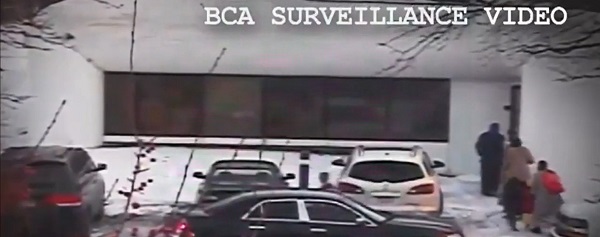Opinion
Tuesday-night Trudeau
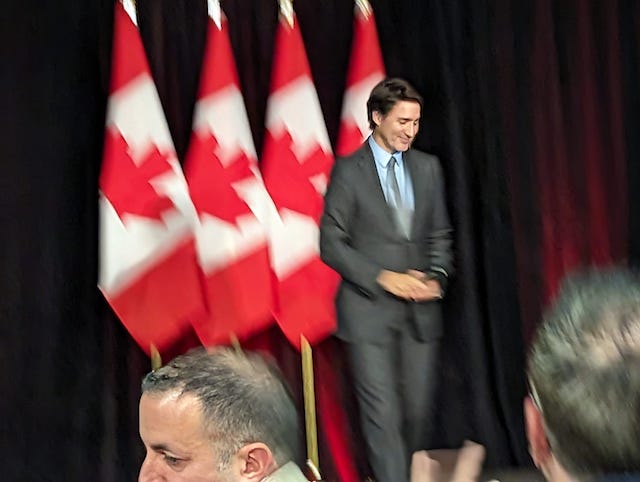
Justin Trudeau at Gatineau Airport, Oct 24 – Photo by PW
Posted with permission from Paul Wells
Justin Trudeau in a hangar, before the comeback, if there’s going to be one
If Justin Trudeau’s historic comeback happens, it will start sometime after Tuesday night, when he spoke to a Liberal Party of Canada fundraiser at the one-runway Gatineau Airport, 21 minutes’ drive from Rideau Cottage on the Quebec side of the river.
The prime minister is two months short of his 52nd birthday. Brian Mulroney was not quite 54 when he became the youngest undefeated prime minister, so far, to announce his retirement from politics. This is the sort of week when I look up numbers like that.
The polls since summer haven’t been kind to the Liberals. I have readers who get cross with me when I mention polls, but I cover the most polling-obsessed government in Canada’s history, and I must decline requests to unilaterally disarm.
Trudeau and his ministers do fundraisers all the time, as do the leaders and prominent MPs in other parties. The only difference on Tuesday was that I went to watch. After some embarrassing early headlines about fundraisers soon after the 2015 election, the Liberal Party changed its rules to increase transparency in fundraising. Now reporters get advance notice whenever Trudeau will be speaking at a fundraiser. I wanted to see what Trudeau says at such things these days, precisely because they’re routine events. Hearing how the prime minister talks to friendlies on a Tuesday night near home was, perhaps, the closest I could get to hearing how he talks to himself.
This event was a fundraiser for Gatineau MP Steven MacKinnon, a former Liberal Party national director who is serving as the government’s house leader while Karina Gould is on maternity leave. Two cabinet ministers were on hand too, Jean-Yves Duclos and Anita Anand. An organizer told the audience he’d been asked to get a smallish crowd out, “a good 50 or so;” since 67 people bought tickets, he was pretty pleased. The party had announced a ticket price up to $1,500. The crowd was of the sort that routinely gets described as overwhelmingly white and male when it’s a Conservative event, which means it was overwhelmingly white and male, but Liberal.
Trudeau spoke for twelve minutes. He opened by saying nice things about MacKinnon and thanked the two cabinet ministers. Poor Duclos thought he was just out to socialize, Trudeau joked, but Duclos is the minister of public services and procurement, “and around here we talk about a bridge.” Gales of laughter from the crowd. The riding association guy had also mentioned a bridge. There has been endless talk about a sixth bridge between Ottawa and Gatineau; neighbours near the various possible routes are leery, but a lot of people hope a new bridge would improve traffic flow, which often includes bumper-to-bumper heavy trucks on ordinary streets through the middle of Ottawa. A lot of the people who want the bridge the most run businesses. Judging from the PM’s choice of comic patter, they won’t have to wait long.
Trudeau thanked the crowd for coming out. “I know very well that everyone has plenty of choices for the various activities they could undertake on a Tuesday night in the month of October,” he said. This may have flattered the selection of fun activities in Gatineau on a Tuesday.
“You chose to come participate in a democratic event,” Trudeau continued. This was an instinct he could only applaud: “We know very well these days that it’s not always very motivating to get involved in politics. To raise your hand and say, ‘No, no, no, I want to participate in our democracy in an active and involved way. To take part in the conversations we’re having as a country in these difficult moments.’”
Trudeau contrasted this positive spirit with what certain other people, so far unnamed, like to do. “It’s very easy to point our finger at politicians, to complain about inflation or the pandemic or interest rates or labour shortages or housing or all these issues. It’s very easy, and many people decide to turn toward anger, anxiety, fear or division. Because it really pays over the short term, in politics, to rely on fear and division. But it’s so much more important to have a responsible, sensible approach, anchored in shared values. To try to bring us together rather than to divide us in an attempt to win a few points in the polls.”
One sensed an emerging central theme of contrast. “Your choice to come tonight to this Liberal event is enormously touching to me,” Trudeau said. “Because for eight years now, we’ve tried to be a government that stayed rooted in real things. In facts. In shared values. We bring people together rather than divide them for strategic reasons.”
Not only does his government, in his telling, think like good people, it does things good people will like.
“We manage to deliver for people. Even in extremely difficult moments like the ones we’re living through. People are struggling, because of the global context, extremely complex geopolitics that have a direct impact on pocketbooks, on groceries and rent. We have an important role to play as a government, to respond to today’s needs. That’s why we’ve made investments to help people pay their bills, to increase competition among the big grocers. We’re there to provide more daycare spaces. We’re there to help with dental care. We’re there to help with the Canada Child Benefit, which has lifted half a million children out of poverty in recent years. We’re there to create economic growth even as we fight against climate change.”
His audience for the night being mostly Quebecers and, as far as I could tell, mostly in business, the Liberal leader refined his course of general flattery to one of specific business-oriented flattery.
“I’m very proud of what we’ve been able to deliver in Quebec: Northvolt, Rio Tinto, REM… These are investments that show how much — here in Quebec where we’ve always understood that environmental protection and economic growth go together — everyone can make progress together.”
This was a pretty upbeat message, as partisan messages often are — we have the right ideas and the right results, and the other team is trying to wreck it all — but here again, as when he lamented how “not very motivating” the political life can be, Trudeau introduced a distinctly mournful note.
“As usual, it’s a bigger challenge to get this message out in the rest of Canada,” he said. At the risk of talking about polls, I couldn’t help thinking Trudeau was referring to recent pee oh ell ells that show Quebec as the only part of the country where his Liberals are in the lead. Despite big federal spending on Volkswagen ($13 billion) and Stellantis (probably more), the clean green future seems not to tempt a lot of Canadians. “It still feels far off, because the day-to-day is still difficult for many Canadians,” he said. “But we know very well that a society and a future are built step by step.…When we stay optimistic, when we’re reasonable, everything becomes possible in the future.”
This, he said, summing up, was “the political debate we’re having now…. Within two years — probably in two years — we’ll have elections.” That’s when people will get a chance to choose directions.
“Will we go back to the Conservative ways of trickle-down, cuts to social programs, advantages for the well-off in the hopes that they’ll eventually give everyone opportunity? It’s never worked and it won’t work better now.” Or would voters stick with the government Trudeau sees in the mirror? “We’re going to stay responsible but we’re going to keep investing,” he said.
Only now, at the end of his remarks, did Trudeau switch from French to English. “It’s always an incredible pleasure to spend time with people who are dedicated every day to building stronger communities and a stronger country.” And that was the end of that. The applause lasted for sixteen seconds. PMO staff led reporters out of the room — our access ends when the big guy stops talking.

A few observations on all this.
First, I’m struck by the way Trudeau narrowed down his expectation of election timing: “Within two years — probably in two years.” Probably anyone in a position of responsibility in any party would say an election could come any time, it’s wise to be ready, and so on. But in Trudeau’s mind, the supply and confidence agreement with the NDP seems likely to hold. He is not in a rush. Judgment Day isn’t until 2025.
Second, if he’s getting any advice to hit pause on carbon taxes, he sure doesn’t sound like he’s getting ready to take the advice. The heart of his case for himself is the notion that you can have clean energy and a thriving economy, and indeed that the latter depends on the former. That argument doesn’t require a carbon tax — theoretically, if you subsidize enough battery plants gasoline will become obsolete — but nothing in Trudeau’s fundraiser stump speech sounded like he was laying the predicate for a major retreat on carbon taxes.
BIG HONKING UPDATE, MINUTES LATER:
The feds have made a large announcement that shows the risks in making predictions. I quote:
“The Prime Minister, Justin Trudeau, today announced the government is moving ahead with doubling the pollution price rebate (Climate Action Incentive Payment) rural top-up rate, increasing it from 10 to 20 per cent of the baseline amount starting in April 2024. People who live in rural communities face unique realities, and this measure would help put even more money back in the pockets of families dealing with higher energy costs because they live outside a large city.
“Given the pressures faced by households and small businesses that use oil heating, the Prime Minister also announced that the government is moving ahead with a temporary, three-year pause to the federal price on pollution (fuel charge) on deliveries of heating oil in all jurisdictions where the federal fuel charge is in effect. This pause would begin 14 days from today. While the fuel charge is already returned to consumers through the pollution price rebate, this temporary pause would save a household that uses heating oil $250 at the current rate, on average, while the federal government works with provinces to roll out heat pumps and phase out oil for heating over the longer term.”
Third, and more generally, the case Trudeau was building was for more of the same. “It still feels far off, because the day-to-day is still difficult for many Canadians,” he said, which is how you talk when you’re hoping your ship comes in before people get a chance to pass judgment.
Incidentally, here I think it’s only fair to point out there’s been recent progress on files I often point to as evidence that Liberal plans never pan out. The Canada Growth Fund, the object of this newsletter’s first post, made its first investment this week, a $90 million equity play in a Calgary geothermal energy company. The Canada-US Energy Transformation Task Force held a second meeting. Maybe two years of process news like that will add up to an electorate that’s excited about Canada’s energy transformation. I mean, it’s possible.
Most of all, I was struck by how “more of the same” had better work for the Liberals, because if the boss has a better idea, he’s hiding it well. A leader who once ran on cost-of-living issues…
… is now running on the clean-energy future that feels tantalizingly out of reach, and lamenting his opponent’s insistence on running on cost-of-living issues. His best hunch about timing is that he has no reason to rush, and his best assessment of his work to date is that he needs to do more of it.
Liberals who feel more of a sense of urgency, futility or wasted energy will just have to get on board, I guess. The leader’s not for turning.
Energy
The global math: Why exporting Canadian energy is a climate win
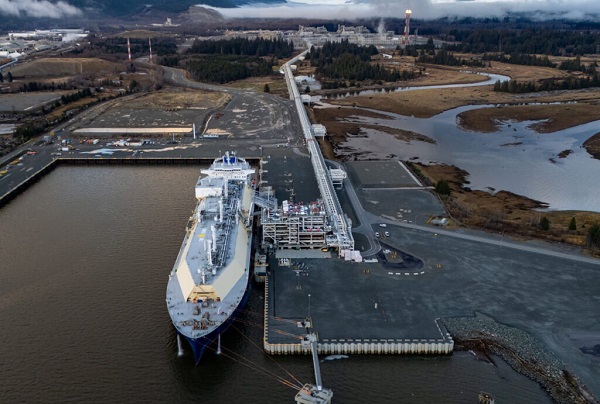
From Resource Works
New report finds that displacing coal and foreign gas with Canadian LNG could lower global emissions by 70 megatonnes a year
Canada’s energy policy debate has become trapped in a polarization that feels dangerously disconnected from global reality.
On one side, we have a domestic conversation focused intensely on our own emissions ledger—counting every tonne produced within our borders as a liability. On the other side is the global reality: a world hungry for energy, often turning to the dirtiest sources available to keep the lights on and economies growing.
I’ve long argued that we cannot solve a global problem like climate change by wearing blinders that restrict our view to the 49th parallel. Recently, on the Power Struggle podcast, I sat down with Mark Cameron to discuss the hard data that backs this up.
Cameron is a fellow at the Public Policy Forum and the co-author of a new report Refuel: What Canadian LNG and Oil Exports Could Mean for Global Emissions. The numbers tell a story that might surprise those who view energy exports solely as a climate negative.
Flipping the script on emissions
The central finding of the Refuel report challenges the orthodoxy that “more production equals more pollution.” When we look at the global picture, the opposite appears to be true.
“The headline news is that if Canada was to increase its LNG exports by [47 million tonnes a year] and if we are exporting primarily into Asian markets, there would be a net reduction in emissions of about 40 to 70 megatonnes per year,” Cameron told me.
Let that sink in. By increasing our economic output and shipping more product abroad, we could lower global emissions by an amount roughly equivalent to taking millions of cars off the road.
It comes down to displacement. The energy we export doesn’t vanish into a void; it replaces other, often dirtier, forms of power generation.
“In some of those markets, you’re displacing coal,” Cameron explained. “Coal obviously is about twice the emissions in generating electricity as LNG. So to the extent that you’re displacing coal, you’re getting a clear emissions reduction.”
The Canadian advantage
This isn’t just about the inherent chemistry of gas versus coal. It is also about the specific quality of the gas produced in Western Canada. Not all liquefied natural gas (LNG) is created equal.
Canada’s geography and technology provide a distinct edge over competitors regarding carbon intensity.
“Canadian LNG, because it has cooler temperatures, shorter shipping times to Asia, more electric drive in its production, is actually about 35 per cent lower in emissions than LNG that would be shipped from, say, the U.S. Gulf Coast,” Cameron said.
When we debate blocking a Canadian project, we act as if the alternative is zero consumption. But the alternative is often gas from the Gulf Coast—which requires more energy to cool in the hot southern climate and takes longer to ship—or worse, coal.
Asian markets know this. They are looking for reliability and lower carbon intensity.
“We want to have a certain percentage of LNG, and we want a certain percentage of that coming from Canada because it’s a stable market and it has a particularly low emissions intensity,” Cameron noted.
The reality of substitution
This brings us to the concept of “carbon leakage.” It is a harsh economic reality that if Canada steps out of the market, we don’t save the planet—we simply cede market share to those with lower environmental standards.
“If the LNG is not coming from Canada, it’s going to come from somewhere else,” Cameron said bluntly. “It’s going to come from the U.S. or Qatar or Australia, or it would be displaced by coal or another energy source. So when you look at all those things in balance, it does look like Canadian LNG is a net positive for the climate.”
Progress in the oilsands
While LNG often dominates the “transition fuel” conversation, the report also addresses the oilsands. The narrative there has often ignored massive strides in efficiency.
“That emissions intensity is coming down. It’s come down by about 30 per cent in the last 20 years,” Cameron said.
He pointed to operational fuel switching as a key driver of this progress.
“Canadian oilsands was using petroleum coke, essentially coal, to generate the steam for the oilsands production. That is almost entirely shifted to natural gas.”
The long game
Finally, we must address the timeline. Critics argue that building LNG infrastructure locks us into fossil fuels. But the transition is a decades-long process.
“There is going to be LNG demand,” Cameron said. “We don’t know exactly how much, but there’s going to be LNG demand for the next four or five, six decades.”
Furthermore, natural gas is a fundamental building block of modern civilization, used for fertilizer and chemical production, not just electricity.
“If we can produce the cleanest LNG in the world, we’re actually doing global climate a favour by building those projects,” Cameron added.
If we retreat from the world stage, we aren’t taking the moral high ground; we are merely outsourcing the emissions to countries with a heavier carbon footprint. A Canada that exports more is a Canada that contributes to a cleaner world.
Watch the video on Power Struggle
- Power Struggle audio and transcript
- Mark Cameron on LinkedIn
- Stewart Muir on X
- Stewart Muir on LinkedIn
Power Struggle on social media:
Energy
Trump’s Venezuela Move: A $17 Trillion Reset of Global Geopolitics and a Pivotal Shift in US Energy Strategy

From Energy Now
The Roosevelt Corollary to the Monroe Doctrine:
“Chronic wrongdoing, or an impotence which results in a general loosening of the ties of civilized society, may in America, as elsewhere, ultimately require intervention by some civilized nation, and in the Western Hemisphere the adherence of the United States to the Monroe Doctrine may force the United States, however reluctantly, in flagrant cases of such wrongdoing or impotence, to the exercise of an international police power.” – 24th U.S. President Theodore Roosevelt’s corollary to the Monroe Doctrine, delivered during his State of the Union Address, December 6, 1904.
The Trump Corollary to the Monroe Doctrine:
“After years of neglect, the United States will reassert and enforce the Monroe Doctrine to restore American preeminence in the Western Hemisphere, and to protect our homeland and our access to key geographies throughout the region. We will deny non-Hemispheric competitors the ability to position forces or other threatening capabilities, or to own or control strategically vital assets, in our Hemisphere.” – Passage contained in the Trump Administration’s 2025 National Security Strategy published November, 2025.
Prologue
In late November, the Trump White House issued a new national security strategy which it says is designed to “reassert and enforce the Monroe Doctrine to restore American preeminence in the Western Hemisphere.” The authors call it the “Trump Corollary” to President James Monroe’s 1823 policy that declared the Western Hemisphere a distinct U.S. sphere of influence.
Under Trump’s corollary, the president maintains he can authorize the Pentagon to engage in “non-international armed conflict” with terrorists. Given that the State Department had earlier designated Venezuela-based Cartel del Soles (Cartel of the Suns) and its affiliated cartel network as international terrorist organizations, and America’s longstanding policy that Nicolas Maduro stole his 2020 re-election and was not the legitimate leader of the country, this corollary frees the U.S. President to take action against him and his regime without seeking prior approval from congress.
It is key to note here that the second sentence of Trump’s new Corollary can logically be applied to both China and Russia and their key strategic investments across Central and South America, including Chinese-controlled port operations at either end of the Panama Canal, in Cuba, and its many other infrastructure investments throughout Central and South America. If President Trump intends to continue applying his new Corollary over his three remaining years in office, he will enjoy a target rich environment.
Trump Applies Both Corollaries to Nicolas Maduro
In the wee hours of January 3, 2025, Trump applied both the Roosevelt Corollary and the Trump Corollary to Nicolas Maduro. Maduro and his wife, Cilia Flores, were taken into custody by U.S. special forces and transported by the military to New York City, where they will face numerous charges related to indictments issued by a federal grand jury in 2020.
During his press conference Saturday morning in which Trump and his key officials detailed the operation to capture Maduro and seize control of the Venezuelan power structure, the President made clear that his administration will set the rules for the re-invigoration of Venezuela’s oil sector. The U.S. hasn’t exactly seized control of petroleum assets worth trillions, but it plans to set the rules of capture, production, refining, and export, and there is every reason to assume those rules will inure to America’s benefit.
Here’s a clip of some of what the President said:
Transcript:
As everyone knows, the oil business in Venezuela has been a bust, a total bust, for a long period of time. They were pumping almost nothing by comparison to what they could have been pumping and what could have taken place. We’re going to have our very large United States oil companies, the biggest anywhere in the world, go in, spend billions of dollars. Fix the badly broken infrastructure, the oil infrastructure, and start making money for the country. And we are ready to stage a second and much larger attack if we need to do so. So we were prepared to do a second wave if we needed to do. We actually assumed that a second wave would be necessary, but now it’s probably not.
[End]
President Trump’s statement that the United States has effectively gained control over Venezuela’s vast crude oil reserves and plans to control the process under which they will be developed and brought to market resets the global energy equation. The President’s further statement that his administration will work hand in glove with, specifically, America’s largest oil companies to restart and rebuild Venezuela’s oil sector no doubt sends shockwaves through corporate C-suites of the world’s biggest corporate drillers.
Which companies stand to benefit from this application of the Trump Corollary? Well, Chevron for one. The Houston-based giant has managed to retain its foothold in the country despite the expropriations of oil company assets executed by both Maduro and former president Hugo Chavez over the last 25 years.
Before Chavez invoked his seizing of assets policies, both ExxonMobil and ConocoPhillips were also big producers in the country. Presumably, Trump’s intention is to also bring those two giants into the rebuilding process.
Keep in mind here that other major companies not based in the United States were also major producers of Venezuelan crude. Those include British-based Shell and BP, as well as French major TotalEnergies and Norway’s Equinor.
It is unclear as of this writing whether those non-U.S. companies will be invited into the new program. But we can be sure that they will attempt to aggressively leverage their ways into the program using whatever means available to them, given the magnitude of the potential prize.
The geopolitical implications are enormous:
- Venezuela sits atop an estimated 303 billion barrels of proven reserves, the largest in the world.
- At current prices hovering around $57 per barrel, that’s a staggering $17.3 trillion in potential gross value.
- Even if extracted and sold at half that rate to account for production challenges, we’re talking about $8.7 trillion – more than the GDP of every nation on Earth except the U.S. and China.

Make no mistake: This move, executed in a swift 12-hour operation, marks a pivotal shift in U.S. energy strategy. For years, Venezuela’s oil wealth has been squandered under the socialist regimes led by Chavez and Maduro, whose mismanagement turned the once-prosperous OPEC founder into an economic basket case. Hyperinflation, corruption, and international sanctions crippled production, dropping output from almost 4 million barrels per day in the late 1990s to about 1 million bpd today. Now, with Maduro ousted, Trump plans to swing the door back open for American firms to revitalize this treasure trove.
This is a geopolitical coup: If properly managed, it could result in a tectonic realignment of global resource flows.
This injection of major new assets into the support structure for the petrodollar system – which had been struggling over the past 3 years to retain its dominance over international trade – combined with the second reminder of America’s unrivaled military might in the past 8 months, re-establishes the United States as the dominant global power. The reassertion of U.S. authority and willingness to enforce the Monroe Doctrine places hundreds of billions of dollars in investments and years of geopolitical maneuvering by both Russia and China at full risk.
Back to oil: Again, if it’s all properly managed – and history tells us it is a very big “if” – this is a move which greatly enhances U.S. leverage over global oil pricing mechanisms for years to come.
From a practical standpoint, unlocking Venezuela’s potential won’t be instantaneous. The Orinoco Belt, home to much of these heavy crude reserves, requires advanced extraction technologies like steam injection and diluents for transport – technologies and processes in which U.S. companies like Chevron and ExxonMobil excel. Past joint ventures under Maduro were hampered by expropriation risks and crumbling infrastructure, but a pro-U.S. interim government could fast-track investments.
The Venezuelan oil sector will be looking at billions in capital inflows, creating jobs in refining, pipelines, and shipping. Still, even with all that new investment flowing in, it can be safely assumed that we are looking at lead times of 5 to 7 years before the sector can be fully restored.
While we know Trump’s plan will be fraught with pitfalls and opposition from a wide variety of interests, the administration and companies likely to become involved do have a nearby success story to use as a model. That model sits right next door in the highly successful development of offshore oil blocks owned by neighboring country Guyana, operated by ExxonMobil.
As it happens, Chevron successfully acquired a 30% interest in the Guyana project last year as part of its buyout of Texas independent Hess Corp. Perhaps an even more interesting aspect of that development is that CNOOC – the Chinese National Offshore Oil Company – is a 25% owner in that Consortium.
Given ExxonMobil’s highly successful and cooperative working relations with the Guyanese government through multiple presidential administrations and Chevron’s uninterrupted operations in Venezuela, no companies are better positioned to help lead the rebuilding effort.
The move to revive Venezuelan oil production also greatly enhances Trump’s leverage in trade negotiations with Canada and its Prime Minister, Mark Carney.
Frustrated with Trump’s tariffs on his oil exports into the U.S., Carney has been working with Albertan Premiere Danielle Smith on a deal to build a massive new pipeline to reroute oil sands crude to the West Coast for shipment to Asian markets. Carney believed he had leverage over Trump in this equation, given that most U.S. Gulf Coast refineries are geared to process the heavy Canadian crude. Now, armed with control over Venezuela’s heavy crude riches, the leverage reverses in Trump’s favor.
Checkmate.
Globally, the ripple effects are profound.
- OPEC+ dynamics shift dramatically; with Venezuela’s output potentially ramping to 2-3 million barrels daily within the next 5-7 years, quota negotiations become a U.S.-influenced affair.
- Russia and Iran, already strained by sanctions, lose further bargaining power.
- Europe, grappling with energy security in what will hopefully soon become a post-Ukraine era, stands to gain a stable Western supplier, but only if its leaders at the EU decide to work more productively and cooperatively with the U.S. government than they have done in recent months.
- China, Venezuela’s top creditor with $60 billion in loans tied to oil shipments, will be forced to recalibrate and decide how best to respond to what it has already denounced as unjustified U.S. aggression.
Critics will decry this as neo-imperialism, echoing Russia’s actions in Ukraine. To which Trump will most likely respond with his best imitation of Ayn Rand’s mythical Atlas shrugging.
It’s important to be clear here: Maduro’s regime functioned as a narco-terror state, propped by human trafficking and drug networks that spilled into U.S. borders, killing tens of thousands of U.S. citizens annually.
This intervention fully aligns with the Monroe Doctrine’s modern revival – protecting the Western Hemisphere from malign influences. Russia and China can complain about U.S. infringement on their investments in the region, but they ignored the potential for an American president invoking the Monroe Doctrine at their own peril. Trump’s new Corollary was no secret – the whole world had every opportunity to read it and reflect on its meaning when it was published in November. If Xi and Putin failed to do that, that’s their failing.
Of course, risks abound. Chinese control of supply chains, legal challenges under international law, and environmental pushback from green activists could and no doubt will complicate extraction. Venezuela’s heavy oil is carbon-intensive, clashing with global net-zero goals. Yet, in the Trump-led rising era of energy realism, physics wins over narratives, and pragmatism overrules ideology, as even green-boosting billionaire Bill Gates recently conceded.
Trump’s critics and America’s rivals must also deal with the likelihood that this move taking down the Maduro regime is almost certainly not the end game, but the first move in a longer campaign that will likely extend to other South and Central American nations actively involved in the drug trade and human trafficking. Those include Colombia, Cuba, and Mexico. Other leftwing bosses in the hemisphere, like Brazil’s Lula da Silva – himself elected under highly suspicious circumstances in 2022 – are no doubt feeling mighty nervous about their own status in light of Trump’s willingness to reapply U.S. regional hegemony.
Bottom line: Trump is scrambling the geopolitical chessboard. Throughout the 20th century and across the first quarter of the 21st, control of oil reserves has always served as the single most important factor in the exercise of geopolitical leverage. With this move into Venezuela, no country controls more massive reserves of oil than the United States does today.
That is All
-

 Haultain Research2 days ago
Haultain Research2 days agoTrying to Defend Maduro’s Legitimacy
-

 International2 days ago
International2 days ago“It’s Not Freedom — It’s the First Step Toward Freedom”
-
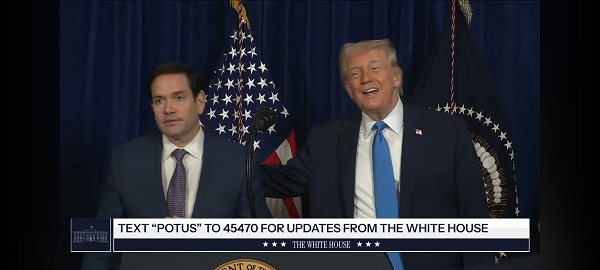
 Daily Caller2 days ago
Daily Caller2 days agoTrump Says US Going To Run Venezuela After Nabbing Maduro
-
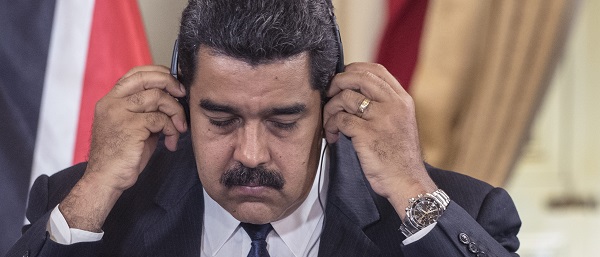
 Daily Caller2 days ago
Daily Caller2 days agoScathing Indictment Claims Nicolás Maduro Orchestrated Drug-Fueled ‘Culture Of Corruption’ Which Plagued Entire Region
-

 Business2 days ago
Business2 days agoVirtue-signalling devotion to reconciliation will not end well
-
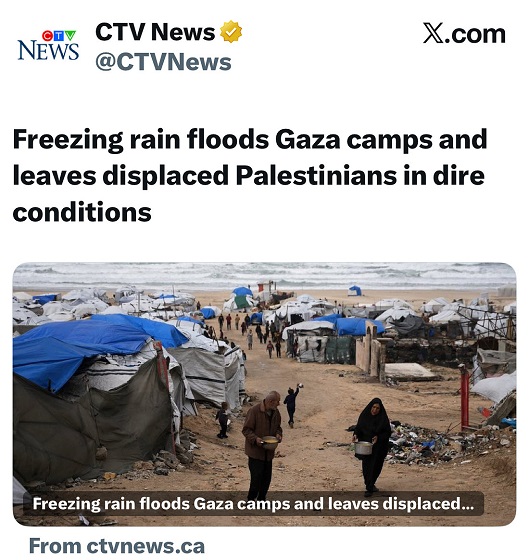
 Opinion1 day ago
Opinion1 day agoHell freezes over, CTV’s fabrication of fake news and our 2026 forecast is still searching for sunshine
-

 COVID-191 day ago
COVID-191 day agoA new study proves, yet again, that the mRNA Covid jabs should NEVER have been approved for young people.
-

 International23 hours ago
International23 hours ago“History in the making”: Venezuelans in Florida flood streets after Maduro’s capture









